How to Implement Scrum in Retail

Retail today is fast-paced and constantly changing. Customer needs shift quickly, new trends emerge overnight, and competition grows tougher each day. Retailers using traditional project management methods often struggle to keep up. That’s why Scrum, a popular agile framework, is increasingly making its mark in retail. Scrum helps retail teams stay flexible, efficient, and customer-focused.
This article explores how Scrum can be implemented effectively in retail businesses and the benefits it delivers.
What Is Scrum?
Scrum is an agile project management method originally designed for software development. It breaks projects into short cycles called "sprints," typically lasting two to four weeks. Scrum teams deliver small increments of value quickly, learn from customer feedback, and improve continuously.
Read more:👉Scrum vs. Scrumban
The Evolution of Scrum in Retail
Retail environments are dynamic. Trends change rapidly, and customer expectations continue to evolve. Traditionally, retailers used rigid planning models, often leading to outdated products and inefficient operations. Scrum’s rise in retail has been driven by the need for faster responsiveness, customer-centric planning, and collaborative work environments.
Transition from Traditional Models to Agile
Shifting from traditional retail operations to Scrum requires a significant mindset change. Traditional methods often rely on lengthy, linear planning cycles, whereas Scrum promotes short iterations, constant feedback, and continuous improvement.
Retailers who transition effectively report enhanced adaptability and customer satisfaction, with increased revenue due to quicker reactions to market shifts.
Benefits of Agile Methodologies in Retail
- Faster market response: Quickly adapt products and promotions based on real-time feedback.
- Higher productivity: Short cycles (sprints) maintain team focus, improving efficiency.
- Customer alignment: Constant feedback loops ensure customer needs drive every action.
Key Components of Scrum
Scrum involves distinct roles, events, and artifacts designed to streamline project management and ensure constant improvement.
Scrum Teams
Scrum teams in retail typically include:
- Product Owner: Defines goals, manages product backlog, ensures tasks align with business priorities.
- Scrum Master: Facilitates team activities, removes obstacles, ensures Scrum practices are followed.
- Development Team: Cross-functional group executing tasks, from merchandising to inventory management.
Scrum Events
Key events in Scrum include:
- Sprint Planning: Teams decide goals and tasks for the upcoming sprint.
- Daily Stand-ups: Short daily meetings that track progress and address challenges.
- Sprint Review: Showcase completed work, gather feedback, and adapt for future sprints.
- Sprint Retrospective: Discuss what worked and didn’t, aiming for continuous improvement.
Scrum Artifacts
- Product Backlog: Prioritized tasks based on customer and business value.
- Sprint Backlog: Tasks the team commits to during a sprint.
- Increment: Completed work at the end of a sprint, ready for review or deployment.
The Scrum Process in Retail
Retail teams implementing Scrum follow structured sprints—typically lasting 2-4 weeks—focused on delivering specific outcomes. Tasks can range from launching seasonal promotions to optimizing inventory management.
Sprint Planning and Its Importance
Sprint planning sets clear, actionable goals. Teams outline what tasks need completion, who handles them, and timelines. Effective sprint planning prevents confusion and aligns all team members.
 Tailor visual workflows to fit your processes in Meegle
Tailor visual workflows to fit your processes in MeegleMeegle simplifies sprint planning by offering visual workflows, clearly defining tasks and responsibilities. Its intuitive interface ensures retail teams can easily plan and adapt their sprints without extensive technical knowledge.
Comparing Traditional Retail Methods and Scrum
Key Differences and Similarities
- Planning: Traditional methods use rigid planning cycles, while Scrum emphasizes flexibility and adaptation.
- Communication: Scrum promotes frequent collaboration, whereas traditional methods often operate in silos.
- Customer Focus: Scrum continuously integrates customer feedback; traditional methods lack continuous customer input.
Similarities:
- Both aim for operational efficiency.
- Both prioritize delivering value to customers, though Scrum achieves this faster.
The Scrum Process in Retail: Step-by-Step Implementation
Step 1: Build Your Scrum Team
Create a cross-functional team. Clearly define roles, particularly the Scrum Master and Product Owner, to ensure accountability.
Step 2: Set Clear Objectives
Clearly define your goals and expectations. Meegle’s visual workflow helps teams see their tasks and progress, fostering goal alignment and accountability.
Step 3: Use Visual Workflows
Implement visual management with Meegle. Visualized workflows clarify tasks and improve transparency, ensuring your team stays aligned and aware of their responsibilities.
Step 4: Execute Sprints
Use Meegle’s robust features to manage tasks throughout sprints. Its clear visual dashboards ensure real-time project visibility.
Step 5: Review and Improve
Regularly conduct retrospectives. Leverage Meegle to quickly identify inefficiencies and improve workflows based on real-time data and feedback.
Challenges of Implementing Scrum in Retail
Common Obstacles and Solutions
- Resistance to Change: Retail teams used to traditional methods may resist Scrum.
- Solution: Conduct ongoing training, demonstrate Scrum's real-world successes, and show clear business benefits.
- Visibility and Collaboration: Teams used to operating in silos might resist open collaboration.
- Solution: Implement visual workflow tools like Meegle, enhancing visibility and accountability among team members.
Importance of Executive Buy-in
Executive support significantly influences Scrum success. Leaders must visibly support Scrum, regularly attend Scrum events, and communicate the benefits clearly to encourage widespread adoption.
Continuous Improvement and Training
Continuous learning is central to Scrum. Regular training sessions ensure teams stay aligned with Scrum principles and processes. Encourage teams to adapt and evolve their skills through continuous feedback.
Meegle simplifies this by providing analytics on team productivity, task completion rates, and improvement areas.
Enhancing Skills for Agile Implementation
Training your retail teams in Scrum basics, communication, collaboration, and problem-solving skills is essential. Regular workshops, role-specific training, and accessible resources ensure teams stay agile and responsive.
Continuous Learning and Adaptation
Continuous learning is core to Scrum success. Encourage regular feedback loops, iterative process adjustments, and open communication. Meegle supports ongoing learning by offering clear data visualizations and analytics that teams can use to adapt continuously.
Listen to Meegle's podcast episode: Overcoming scope creep with Agile project management
Real-World Case Studies: Meegle in Action
Implementing Scrum successfully in retail businesses requires the right tools to streamline processes, improve collaboration, and simplify complex workflows. Here is a genuine example showcasing how Meegle has driven productivity, visibility, and workflow efficiency in a well-known company:
POP MART: Rapid Launch through Visual Workflows
 Overview of projects in Meegle
Overview of projects in MeeglePOP MART, a global retailer known for collectible art toys, faced a tight deadline to launch its e-commerce platform. Their challenge was coordinating multiple teams and managing parallel tasks efficiently.
By adopting Meegle, POP MART established standardized visual workflows that clearly defined each stage of the project. Using node-driven workflows, team members could see exactly which tasks were pending, completed, or required attention. This enhanced clarity significantly cut down unnecessary communications.
Impact:
POP MART successfully launched its e-commerce system in just 8 days, which typically might have taken weeks. This rapid deployment was possible due to Meegle’s intuitive, visual interface that ensured team alignment, quick identification of task dependencies, and better resource allocation.
Why it matters for Retail Scrum implementation:
Retail businesses thrive on speed and adaptability. The successful launch of POP MART's e-commerce site highlights Meegle’s capacity to accelerate go-to-market strategies using Scrum. Clear visuals allow retail teams to spot potential bottlenecks in advance and address them rapidly, aligning perfectly with Scrum’s principles of transparency and iterative improvements.
Experience agile retail execution with Scrum-aligned workflows—get started with Meegle today.
The world’s #1 visualized project management tool
Powered by the next gen visual workflow engineRead More
Check All BlogsStart creating impactful work today



